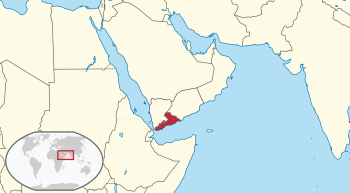Federation of South Arabia facts for kids
Quick facts for kids
Federation of South Arabia
اتحاد الجنوب العربي
Ittiḥād al-Janūb al-‘Arabī |
|||||||||||||
|---|---|---|---|---|---|---|---|---|---|---|---|---|---|
| 1962–1967 | |||||||||||||
 |
|||||||||||||
| Status | British protectorate | ||||||||||||
| Capital | Aden | ||||||||||||
| Common languages | Arabic English South Arabian |
||||||||||||
| Government | Federal monarchy | ||||||||||||
| High Commissioner | |||||||||||||
|
• 1963
|
Sir Charles Johnston | ||||||||||||
|
• 1963–1964
|
Sir Kennedy Trevaskis | ||||||||||||
|
• 1964–1967
|
Sir Richard Turnbull | ||||||||||||
|
• 1967
|
Sir Humphrey Trevelyan | ||||||||||||
| Chief Minister | |||||||||||||
|
• 1963
|
Hassan Ali Bayumi | ||||||||||||
|
• 1963–1965
|
Zayn Abdu Baharun | ||||||||||||
|
• 1965
|
Abdul-Qawi Hassan Makkawi | ||||||||||||
|
• 1965–1966
|
Ali Musa al-Babakr | ||||||||||||
|
• 1966–1967
|
Salih al-Awadli | ||||||||||||
| Historical era | Cold War | ||||||||||||
|
• Established
|
4 April 1962 | ||||||||||||
|
• Independence
|
30 November 1967 | ||||||||||||
| Currency | South Arabian dinar | ||||||||||||
|
|||||||||||||

The Federation of South Arabia (FSA) was a group of states in the southern part of the Arabian Peninsula. It was under the protection of the British government. This area is now part of modern-day Yemen. The capital city of the Federation was Aden.
Contents
A Brief History of the Federation
The Federation of South Arabia was officially created on April 4, 1962. It brought together 15 smaller states that were already under British protection. These states had been part of something called the Federation of Arab Emirates of the South.
In January 1963, the State of Aden joined the Federation. Aden was a very important port city. By June 1964, another state, the Upper Aulaqi Sultanate, also joined. This made a total of 17 states in the Federation.
The Federation even sent a team to the 1966 Commonwealth Games in Jamaica. This showed that it was recognized on the world stage.
However, the Federation did not last long. On November 30, 1967, it was dissolved. This happened when British protection ended. The Federation, along with the nearby Protectorate of South Arabia, then became a new independent country called the People's Democratic Republic of Yemen.
The States That Formed the Federation
The Federation of South Arabia was made up of 17 different states. These states were often led by their own local rulers, such as sultans, emirs, or sheikhs. They included:
- The State of Aden
- Various Sultanates like Audhali, Fadhli, Haushabi, Lahej, Lower Aulaqi, Lower Yafa, Upper Aulaqi, and Wahidi.
- Several Sheikhdoms such as Alawi, Aqrabi, Dathina, Muflahi, and Shaib.
- Emirates like Beihan and Dhala.
These states joined together to form a larger federal state. This was done to create a more unified region under British guidance.
Leaders of the Federation
The Federation had different leaders during its short existence. These included Chief Ministers and High Commissioners.
Chief Ministers
The Chief Minister was like the head of the government for the Federation.
- Hassan Ali Bayumi (January 1963 – June 1963)
- Zayn Abdu Baharun (July 1963 – January 1965)
- Abdul-Qawi Hassan Makkawi (March 1965 – September 1965)
- Ali Musa al-Babakr (September 1965 – August 1966)
- Salih al-Awadli (August 1966 – November 1967)
High Commissioners
The High Commissioner was a British official. They represented the British government in the Federation.
- Sir Charles Johnston (January 1963 – July 1963)
- Sir Kennedy Trevaskis (July 1963 – December 1964)
- Sir Richard Turnbull (December 1964 – May 1967)
- Sir Humphrey Trevelyan (May 1967 – November 1967)
Postage Stamps of the Federation
The Federation of South Arabia even had its own postage stamps! These stamps were issued from 1963 to 1966. Many of them were part of special stamp sets. These sets were common for all British Commonwealth territories.
On April 1, 1965, the Federation released its own unique set of stamps. There were 14 different stamps in this set. Ten of them showed the Federation's official emblem in a single color. The other four, which were higher value stamps, featured the flag of the Federation.
Collecting these stamps can be a fun way to learn about the history of the Federation.
Images for kids
See Also
















